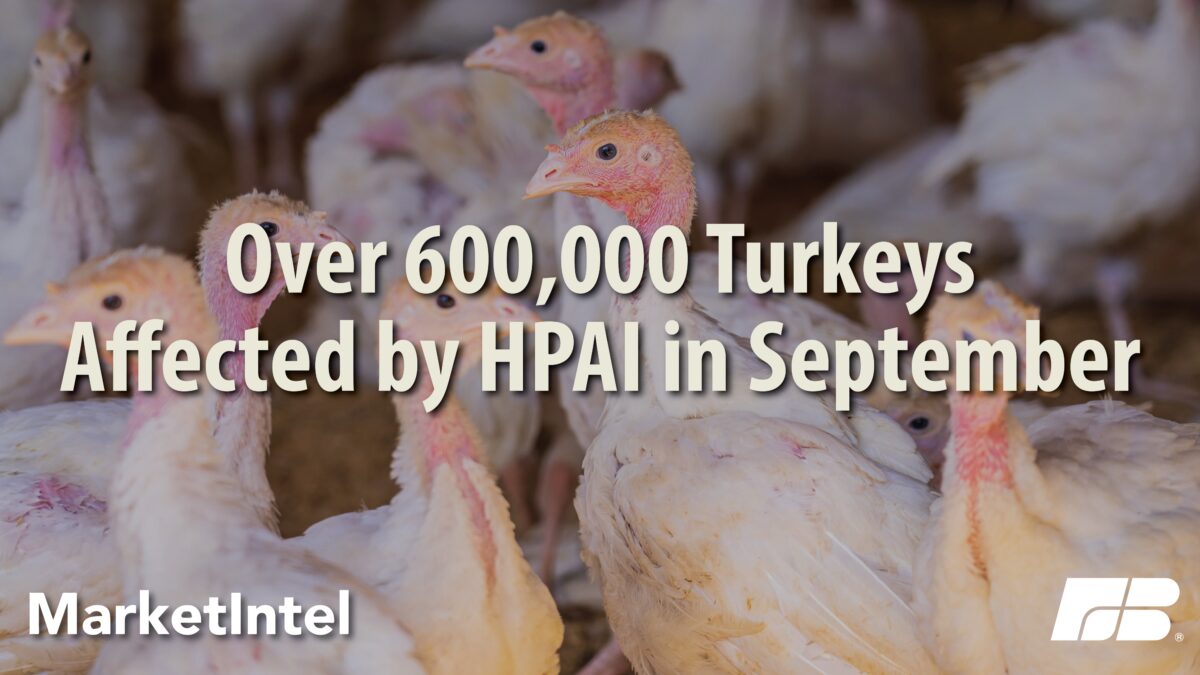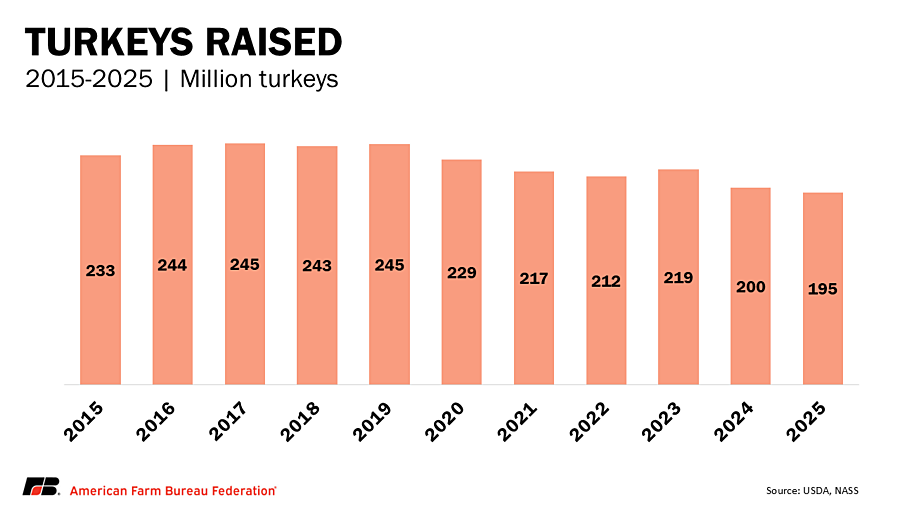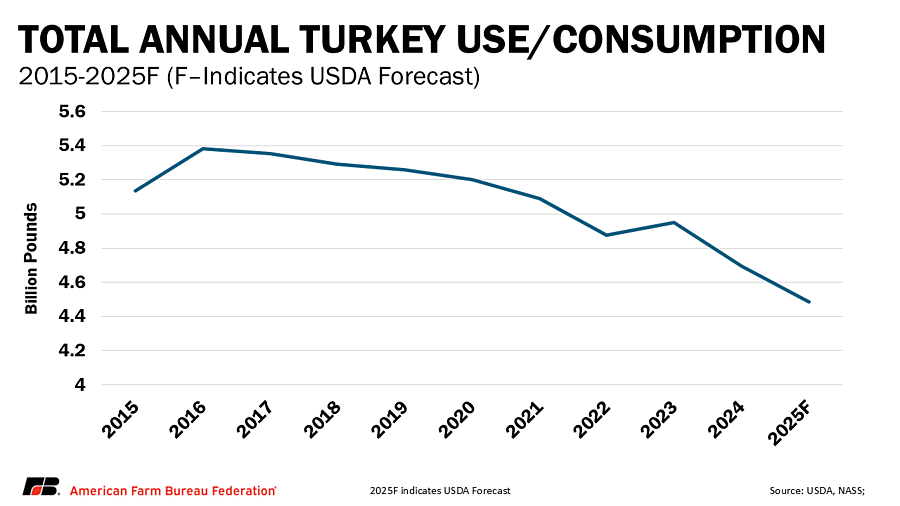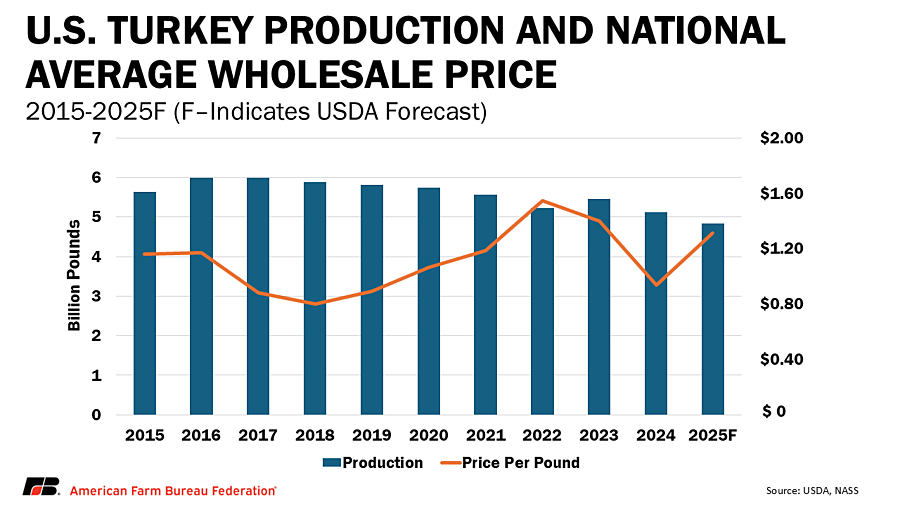Turkey Farmers Brace for Uptick in HPAI

Bernt Nelson
Economist
As Thanksgiving draws near, turkey will start making it onto grocery lists across the country. After a quiet summer, Highly Pathogenic Avian Influenza (HPAI) is again being detected in turkey flocks in the Upper Midwest. This Market Intel evaluates disease and other issues facing the turkey industry and what consumers can expect as Thanksgiving approaches.
Disease
Highly Pathogenic Avian Influenza (HPAI)
HPAI has had a major impact on the turkey industry, affecting about 18.7 million turkeys and accounting for 10% of all birds affected by the virus since 2022. This includes 2.2 million turkeys affected so far in 2025. HPAI detections slowed over the summer months with only seven total detections from June 1 to Sept. 1, affecting 428,280 birds. Fall waterfowl migration season has started, resulting in 15 total detections in North Dakota, South Dakota, Minnesota and Wisconsin poultry flocks this month alone, affecting 3.75 million total birds in September. Turkeys accounted for 606,600, or about 17%, of the birds affected this month. With much of the migration season still ahead, the industry faces the likelihood of additional HPAI cases in the coming weeks.
Avian Metapneumovirus (AMPV)
Avian Metapneumovirus (AMPV ) is a highly contagious, viral upper respiratory disease that affects poultry and wild birds. Clinical symptoms include coughing, discharge from nostrils, swollen heads and in later stages, neurological symptoms.
AMPV subtype A and B were detected in the U.S. in January 2024. Prior to 2024, only subtype C was known to be present. After the first detections in January these new subtypes spread rapidly. In less than six months, subtype A or B or both were detected in 26 states and two Canadian provinces.
The National Turkey Federation estimated that AMPV was present in 60-80% of turkey flocks in 2024 and continues to be a problem. AMPV is less lethal than HPAI, and USDA’s Center for Veterinary Biologics recently allowed the importation of several vaccines. Affected birds can also be treated for any secondary infections caused by AMPV, which may reduce the severity of the disease. One of the greatest impacts of AMPV is a reduction in egg sets for breeders producing the next generation of turkeys to replace losses from HPAI. Breeders face a tough road with the risk of egg-laying birds becoming infected with either HPAI, AMPV or both. Excellent biosecurity, cleaning and downtime between flock placements are the best tools for prevention and control outside of vaccination.
Turkeys Raised
With fall disease pressures from HPAI and AMPV intensifying, the overall size of the U.S. turkey flock continues to reflect these challenges. USDA’s Turkeys Raised report contains the number of turkeys raised in the United States, along with historical trends and data for major turkey-producing states for the last two years. The most recent report, released on Sept. 26, estimates that 195 million turkeys were raised in 2025, down 3% from 2024, and down 36% from a peak of about 303 million in 1996. This marks the lowest estimate in 40 years when185 million turkeys were raised in 1985 and will lead to higher prices for consumers.
Turkey Hatchery – Trying to Keep the Industry Supplied
Another key indicator is USDA’s monthly Turkey Hatchery report which contains the number of turkey eggs in incubators on the first day of the report month and poults (young turkeys) placed on feed during the previous month. These numbers reflect the pipeline that sustains turkey production, even as HPAI and AMPV pressure flocks and challenge supply. In addition, poults hatched and poults placed in June 2025 were both 5% higher than June 2024. Eggs in incubators in August 2025 were 24.9 million eggs, up 4% from July and the highest number since April. While this is the highest number of eggs in incubators since April, it’s down about 8% from 27.16 million five years ago. This underscores the impact of HPAI and AMPV on layers’ ability to replenish birds lost to disease. Excellent biosecurity and cleaning are essential for breeders to minimize the risk of lower egg sets from AMPV infections.
Production
Beyond flock numbers, actual production is also declining, USDA’s Livestock, Dairy, and Poultry Outlook, released on Sept. 18, estimates July turkey production was 426.6 million pounds, up about 11 million pounds, or 2.6%, from June, but down slightly from July 2024. USDA’s September World Agricultural Supply and Demand Estimates (WASDE) projects total 2025 turkey production will be 4.84 billion pounds, down 1.8 billion pounds, or 5%, from 2024 and down 11% from nearly 5.5 billion pounds in 2023. This historically low production is the result of the many challenges facing the industry – increased detections of HPAI, AMPV, declining demand and industry consolidation.
USDA’s September 2025 net farm income forecast projects total cash receipts from turkeys will be $4.8 billion, up $1.13 billion or 30% from 2024 but down 30% from $7.12 billion in 2022 when the current HPAI outbreak began. The contrast highlights how disease pressures like HPAI and AMPV can send the industry on a roller coaster — boosting prices one year while suppressing production and revenue the next.
Demand
Even though turkey supplies are lower than historical averages, demand is also down over the last few decades and there will be plenty of turkey for the holiday season. USDA’s latest WASDE report
projects 4.49 billion pounds of turkey will be consumed or exported in 2025, down 610 million pounds, or 12%, from 2015. According to the National Turkey Federation, Americans consume around 46 million turkeys, or about 1.4 billion pounds of turkey, during the Thanksgiving holiday. This accounts for more than a quarter of total 2025 U.S. turkey production consumed in one day.
Imports
International trade also plays a role in balancing U.S. turkey supplies. U.S. imports of turkey and turkey products have been very consistent. USDA’s latest WASDE report projects about 36 million pounds of turkey will be imported in 2025, down 1 million pounds from last year and unchanged from a decade ago. The U.S. imported about 24 million pounds of turkey from Canada in 2024 along with about 12 million pounds from Chile and four thousand pounds from Mexico. Canada, Chile and Mexico have been the only source countries for turkey imports since 2021.
Exports
USDA’s WASDE also forecasts 417 million pounds of turkey exports in 2025, up 5 million pounds from last month’s estimates, but down 69 million pounds, or about 14%, from 2024. U.S. turkey exports have largely followed the larger decline in domestic production, with exports falling by 388 million pounds, or 48%, since 2015 when production was about 15% higher than USDA’s current forecast. Mexico was the largest export destination for U.S. turkey in 2024, receiving over 365 million pounds of turkey or 75% of all turkey exports by volume. Canada was the second-largest destination, receiving about 11.4 million pounds or 3% by volume.
Prices
The combined effect of disease, supply and demand trends is reflected in turkey prices. USDA recently forecasted that the 2025 national average composite wholesale price for a frozen whole hen turkey will be $1.32 per pound, up 4 cents per pound from last month’s forecast and up 38 cents per pound, or 40%, from the 2024 price of 94 cents. The 2025 rise in price is a response to lower production with HPAI pressures combined with steady demand.
Summary and Conclusions
Wholesale turkey prices are about 40% higher due to supply challenges from the impact of HPAI and AMPV. While these prices are helpful, it’s important to remember prices are still 32% lower than just three years ago. Diseases such as HPAI and AMPV are devastating flocks. Meanwhile, poultry farmers also grapple with the broader economic challenges facing the agricultural economy. These production challenges shouldn’t have any impact on consumers’ ability to get turkey, but they may translate to higher retail prices this holiday season.
Keep an eye out for the results of this year’s American Farm Bureau Federation’s Thanksgiving dinner survey, which will be released on Nov. 19. This survey provides prices for a set basket of goods including turkey and other Thanksgiving favorites to give shoppers a snapshot of what they can expect to pay as they head to grocery stores to stock up for the big day!
Top Issues
VIEW ALL


